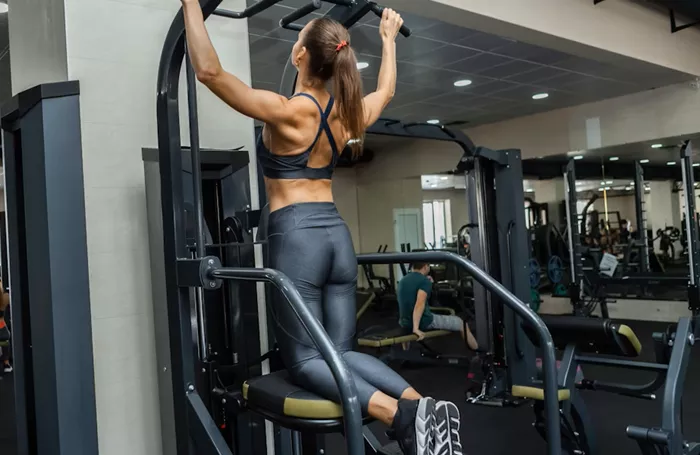The assisted pull-up is a strength training exercise. It mimics the traditional pull-up but provides support. This support makes the movement easier. Beginners or those lacking upper body strength benefit from it. Assisted pull-ups help build strength gradually. They also improve form and confidence.
Understanding the Pull-Up Movement
A standard pull-up involves lifting your body. You use your arms, back, and shoulders. The bar is usually above your head. You grip it with both hands. Then you pull yourself up until your chin is over the bar. This action uses your body weight as resistance.
Muscles Used in a Pull-Up
- Latissimus dorsi (lats)
- Biceps brachii
- Trapezius
- Rhomboids
- Deltoids
- Core muscles
This makes pull-ups a compound exercise. It targets multiple muscle groups. It also enhances coordination and control.
What Is an Assisted Pull-Up?
An assisted pull-up reduces the weight you need to lift. It uses external assistance. This can be a machine, a resistance band, or a workout partner. The goal is to allow you to complete the movement. It helps you train the same muscles with less strain.
Types of Assisted Pull-Ups
1. Machine-Assisted Pull-Ups
These are found in gyms. The machine includes a platform or knee pad. You set the amount of assistance. The more weight you set, the easier it gets. This is suitable for beginners or people recovering from injuries.
2. Band-Assisted Pull-Ups
Resistance bands are flexible and portable. You loop a band over the pull-up bar. Then you place your feet or knees into the band. The band stretches as you pull up, helping you rise. It’s a popular choice for home workouts.
3. Partner-Assisted Pull-Ups
A workout partner can hold your feet or support your back. This is useful if you have no equipment. However, it requires coordination and trust.
Benefits of Assisted Pull-Ups
Builds Upper Body Strength
Assisted pull-ups work the same muscles as regular pull-ups. Over time, they strengthen your back, shoulders, arms, and core. As your strength improves, you will rely less on assistance.
Improves Muscle Coordination
This exercise teaches your body how to move efficiently. Your muscles learn to work together. That builds better body awareness and control.
Great for Beginners
Pull-ups can be discouraging. Many people cannot perform even one. Assisted versions allow gradual progression. This builds confidence and motivation.
Reduces Risk of Injury
Struggling to lift your entire body can strain muscles and joints. Assistance reduces the load. This lowers the risk of injury, especially for novices.
Adapts to Different Fitness Levels
You can change the assistance as you improve. Use lighter bands or reduce the machine’s counterweight. This makes assisted pull-ups suitable for everyone.
How to Perform an Assisted Pull-Up
With a Machine
- Step onto the machine and adjust the weight. The more weight, the easier the pull-up.
- Grasp the handles with an overhand grip.
- Kneel or stand on the platform.
- Pull yourself up until your chin passes the bar.
- Lower yourself slowly to the starting position.
With a Resistance Band
- Loop the band over the bar and pull one end through the other.
- Place your foot or knee into the band.
- Grip the bar with both hands.
- Pull yourself up using the band for support.
- Lower yourself under control.
Common Mistakes to Avoid
Relying Too Much on Assistance
Using too much support reduces muscle activation. It limits your progress. Reduce assistance as your strength grows.
Inconsistent Form
Do not swing or use momentum. Maintain proper posture. Keep your core engaged and move slowly.
Neglecting Eccentric Movement
The lowering phase (eccentric) is vital. Don’t drop quickly. Lower yourself slowly to build strength.
Improper Band Use
Ensure the band is secure. If it slips, you might get injured. Always check before using.
Progressing to Unassisted Pull-Ups
Start with high assistance. Then reduce support gradually. Aim to do one unassisted pull-up. Increase reps over time.
Additional Strength Exercises
- Lat pulldowns
- Bicep curls
- Rows
- Planks
- Push-ups
These exercises target the same muscles. They complement pull-up training. Consistency is key.
Integrating Assisted Pull-Ups into Your Routine
Include them 2–3 times per week. Start with 3 sets of 5–10 reps. Rest 1–2 minutes between sets. Combine with other exercises. For example, pair them with a Cardio Workout or strength circuit. This makes your training well-rounded.
Assisted Pull-Ups and Anaerobic Training
Pull-ups are an anaerobic movement. They involve short bursts of effort. Assisted pull-ups are ideal for Anaerobic Training. They help you perform more reps with proper form. This increases muscle endurance and power.
Do Assisted Pull-Ups Burn Fat?
While not primarily for fat loss, they boost muscle mass. More muscle burns more calories. Pair them with Cardio Exercise for best results. A balanced workout promotes fat loss and strength.
Tips to Maximize Your Results
Stay Consistent
Regular training brings better results. Track your progress. Set goals and stay motivated.
Eat a Balanced Diet
Fuel your body. Protein helps repair muscles. Carbs give you energy. Fats support recovery and hormones.
Rest and Recover
Don’t overtrain. Give your muscles time to heal. This prevents injury and boosts gains.
Conclusion
Assisted pull-ups are a powerful way to build strength. They prepare you for full pull-ups. They help you train safely and effectively. Whether you’re a beginner or returning from injury, they offer progress. Use them with consistency. Mix them with Cardio Workout Plans and strength routines. Over time, you’ll see major improvements. And one day, you’ll do pull-ups unassisted — with ease and pride.

